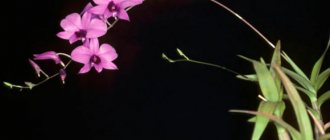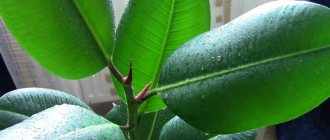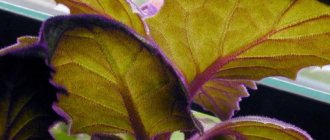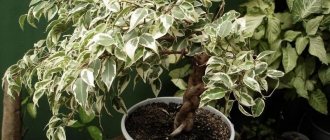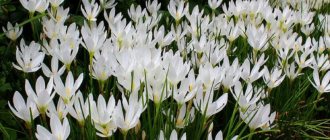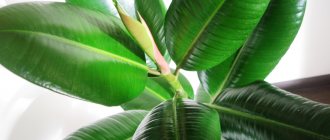Along with geraniums and balsams, rubber ficus is a popular inhabitant of window sills. It is believed that the perennial with large (up to 30 cm in length) dark green leaves and red stipules brings prosperity to the family.
The name of the culture speaks for itself. Europeans have long used the shoots of the plant to produce rubber. That's why some call ficus rubber tree or elastica.
Species diversity
More than 1000 species of ficus grow in their natural habitat. In indoor floriculture, the most popular varieties are Robusta, Tineke, and Belize. Despite their close relationship, each species has its own characteristics and nuances of content.
Features of seasonal care
Important details:
- spring is the growing season, a suitable time for hygienic pruning, pinching the top and forming the crown. Fertilize with mineral and organic fertilizers, water moderately, keep the flowerpot with ficus in a warm but not hot room (about +23°C);
- summer. The growth period continues, the flower becomes more magnificent, many young leaves and side shoots appear (provided that the top is pinched in a timely manner). Feeding twice a month and loosening is useful. The room should be warm. In hot weather, it is important to spray the flower every day or wipe large leaves with a damp cloth or soft washcloth;
- autumn - the beginning of the dormant period (from October), slow movement of juices. No fertilizing is carried out, watering is rare, but too dry soil is a bad option. Be sure to move the flower pot with ficus to a cool room (about +16°C). You cannot take the plant out onto the balcony in cold weather: at temperatures below +13 degrees, illness and death of the tropical flower is possible;
- winter. The decorative foliage species is resting and the dormant period continues. Crown formation and hygienic pruning cannot be carried out, watering is very rare, fertilizers are temporarily not applied. The dormant period gives the plant time to prepare for the growing season when spring arrives. The plant is in a cool room, but there should be no dampness or “deep” shade: moderate light is needed.
Tineke
Among the characteristic features of the variety is a two-color leaf blade. In the photo of the rubber ficus Tineke, it is clearly visible that the middle of the leaf is green, and the edges are framed by a white-yellow border.
Considered a capricious culture. If not properly cared for, it loses its decorative effect.
Belize
It is a variegated species, differing from the previous species by pink spots on the foliage. It will not cause many maintenance problems if you place the pots in a well-lit place.
Watering
The frequency of watering depends on the time of year and the established temperature conditions. In summer it is allowed to water the flower twice a week, in winter - once.
One of the important rules for growing rubber ficus at home is moderate watering. Flooding is unacceptable - this can cause the tree to shed its leaves. It is better to use soft, settled water.
Note to the florist
Why does the rubber ficus shed its leaves?
An adult plant sheds its lower leaves; this is a natural process. If young leaves begin to fall off, there may be several reasons:
- Excessively wet soil;
- Insufficient watering;
- Sudden change in temperature;
- Draft;
- Lack of light.
Harm and benefits of rubber ficus
Ficus does not cause any harm to human health. But there is no doubt about the benefits of the plant. It has been established that ficus helps purify indoor air by converting harmful substances into safe amino acids and sugars.
There is also an opinion that the plant is capable of purifying the energy of a room, absorbing streams of anger and hatred. Families without children are often advised to place a ficus tree in the house.
The leaves and juice of the plant are often found in traditional medicine recipes. It is used to treat cancer tumors, fibroids, uterine fibroids, arthritis, radiculitis and osteochondrosis.
Lighting
A window facing west or east is an ideal location. In this case, the perennial receives a sufficient amount of bright, diffused light.
Elastic also tolerates shaded areas well. In the shade, the plant may develop a little slower than in the light, but this does not affect the general condition.
Humidity
In summer, daily spraying is carried out from a spray bottle. Once every 2-3 weeks, the leaf blades are cleaned of dust and dirt with a damp sponge.
Elastica responds well to a warm shower, while the soil in the pot is covered with film. In winter, they usually limit themselves to wiping the leaves.
Varieties with photos
A significant number of varieties have been bred. All cultivated varieties are more compact than their wild ancestor.
Variegated or variegated species require more light when growing than varieties with monochromatic foliage.
The most popular are the following varieties.
Tineke
Variegated variety. The leaves are oval with a pronounced point at the end. The length of the sheet is within 25 cm, width - about 15 cm. It has a smooth surface and smooth edges. The decorative pattern is created by uneven areas of white, brownish and green colors. When grown in bright light, young leaves have a pinkish tint to the central vein.
Features of care:
- ficus Tineke needs more light and heat than green-leaved varieties;
- requires high humidity.
Variety Tineke in the photo:
Abidjan
Pointed green leaves. There is a vein of a soft green hue, which is colored burgundy underneath. The leaves are 25 cm long and 17 cm wide. Depending on growing conditions, foliage color can vary from green (in European growers) to dark beetroot (in Florida).
Features of cultivation:
- Extremely afraid of drafts.
- Before transplanting into a new pot, the plant must get used to the new place for 2-3 weeks. Ficus does not like to change conditions and may lose its leaves.
- It is recommended to pinch at a level of 20 cm.
Variety Abidjan in the photo:
Belize
A variegated variety native to Holland. It has an original color with streaks of pink, white and cream. The shape of the leaves is elongated and pointed. Size 23cm. by 13 cm. The central vein has a rich pink color.
Features of care:
- Need bright light. If there is a deficiency, the variegation goes away and the green color begins to predominate.
- In warm weather, it is recommended to take it out onto the balcony for air baths.
- In summer, watering is done every other day, in winter - every other week.
- Make sure that when transplanting, the root collar is level with the soil.
Variety Belize in the photo:
Black Prince
A distinctive feature is the darker color of the leaves. Depending on the lighting, they may appear almost black. Hence the name. The top leaf is reddish in color. The leaves are more rounded, the width reaches 20 cm. In the center there is a burgundy-colored vein.
Black Prince sends out aerial roots to draw moisture from the air and support the crown. This variety requires a significant area and grows large depending on the size of the pot and the height of the ceiling.
Features of care:
- Avoid rearrangement. Choose a place for it right away and don’t move it.
- Doesn't like drafts.
- You need good drainage, a permeable substrate and a clay pot to allow the roots to breathe.
- Enough light, otherwise the foliage will lose its rich color.
Variety Black Prince in the photo:
If water stagnates, the roots will rot and the plant will die.
Important! To stimulate the growth of new shoots, the trunk is pierced a third of the diameter with a clean needle.
Robusta
One of the most unpretentious varieties. It has large leaves reaching a length of 30 cm. The color is rich green, sometimes with yellow and white patterns.
Belongs to tall varieties and needs timely pruning.
Features of care:
- avoid drafts;
- watering with settled water after the top layer of soil has dried;
- location - near the window in the shade.
Robusta variety in the photo:
Soil and feeding
For ficus, organize a substrate consisting of equal parts of turf, leaf and sandy-peat soil. Fertilizer is applied only during the period of active growth.
It is recommended to alternate organic and mineral fertilizers. In flower shops you can purchase liquid nitrogen-containing fertilizers for indoor crops.
Home care
In the wild, he is not afraid of either the sun or rain. However, cultivated varieties require more careful care. Given the significant dimensions of an adult bush, it is necessary to take care of sufficient space in the apartment. Before purchasing a plant, consider whether you can provide it with suitable conditions.
What kind of soil is needed?
Prefers porous, permeable soil. If you plant a plant in a purchased peat substrate, you should add to it:
- turf soil;
- humus;
- sand.
Mixtures can be prepared in the following proportions:
- 2 parts of leaf and turf soil and 1 part of sand.
- 2 parts of leaf soil and 1 part of peat and humus.
The inert substrate in which ficus plants are grown for sale contains no humus. After acquisition, it is necessary to replant it in more fertile soil or regularly use fertilizing.
Temperature and lighting
The optimal summer temperature is 25-28 °C. Under conditions of frequent spraying, it can tolerate higher temperatures. In winter, the thermometer should not fall below 15 °C.
Can withstand short-term decreases to +5 °C. But in this case, cooling of the earthen coma is excluded. Ficus does not react well to freezing roots. It is not recommended to place the pot on a cold floor or windowsill. To avoid hypothermia, place a foam tray under the container.
When the temperature drops, the flower should not be subjected to water procedures. Wet foliage will freeze and fall off. Drafts are unacceptable; they lead to the shedding of leaves.
Lighting must be sufficient. It is best to place it in a place with diffused light. It is acceptable to place a specimen with green leaves in a shaded area. Variegated species need more light, otherwise the leaves will change color and the spectacular variegation will disappear.
Suitable fertilizer for the type
From March to September it is necessary to feed alternately with organic and mineral fertilizers. During the period of active growth of green mass, fertilizers with a high nitrogen content are applied. Closer to autumn, nitrogen gives way to phosphorus.
Nitrogen fertilizers in the autumn-winter period in the absence of sufficient lighting will lead to the appearance of weak, elongated sprouts.
Feeding in the cold season is permissible only with active supplementary lighting, when a 12-hour daylight hours are organized. Normal growth then continues.
Reference. In the warm season, fertilizers are applied once every 2 weeks. Nitrophoska can be used as a mineral complex at the rate of half a teaspoon of the substance per 1 liter of water. Other complex mineral fertilizers are also suitable.
The following are used as organic ones:
- mullein;
- bird droppings;
- humus.
Fertilizers are applied 30-40 minutes after watering. Otherwise, you can burn the roots.
Water with settled water at room temperature. Rubber-bearing ficus does not tolerate too much watering.
This procedure is carried out when the top layer of soil has dried to a depth of 3 cm.
If it is more convenient for you to feed the flower at the same time as watering, then make a solution that is 2 times less concentrated. Fertilizers should not get on leaves or growth buds.
Video about feeding rubber ficus:
How to replant?
The young plant needs annual replanting. An adult is transplanted once every 2-3 years.
Important! The old flower may suffer and die during transplantation. Therefore, it is recommended not to remove it from the pot, but to carefully remove the top layer of soil to a depth of 3 cm and replace it with a new substrate.
A sign that the soil is depleted and requires replacement is the rapid flow of water into the pan when watering.
Transplantation is carried out in the spring. How to do it:
- Prepare a new container larger than the previous one by 5-6 cm in depth and 4-5 cm in diameter.
- Prepare fresh soil by mixing turf soil, sand, peat and leaf soil in equal proportions.
- Moisten the substrate in the ficus pot so that the earthen ball with the bush can be easily removed.
- Add a good layer of drainage to the new container.
- Remove the clod of earth with the plant and place it in the prepared container. Do not clear the roots from the ground. Transplantation is carried out by transshipment.
- Fill the voids with soil to the top of the pot.
- Water no earlier than after 4 days.
Because ficus is sensitive to rearrangement, place the transplanted bush in its old place, turning the same side to the light source.
Pruning
To give a decorative shape, trimming is carried out. If this is not done, the ficus will stretch upward. As it grows, the lower leaves will die and the stem will be exposed.
Prune at the end of winter. Later pruning will lead to the fact that the side buds will not sprout, and only the top one will wake up. You won't get a lush bush. The same thing will happen if you cut off the very top. Therefore, at least 5 upper internodes are cut off.
Attention! The cut is made with a sharp knife. The blade should be disinfected. The released juice is washed off with running water.
Another method is used to give the plant branching. The stem is bent and fixed in this position. In this case, the bud that is located highest above the level of the pot will wake up. The sprout from it will develop intensively. When it reaches the desired size, the barrel can be returned to its original position.
Below is a video about transplanting and pruning rubber ficus:
Transplantation and propagation
Young specimens are replanted every year, older trees - every 3 years. The new pot must be larger than the previous one, and drainage must be placed at the bottom.
- Development of technological production regulations
- Phloxes in personal plots
Ficus transplantation: step-by-step instructions on how and when to replant various types of indoor ficus plants (135 photos and videos)
Both classical transplantation and transshipment with an earthen clod are allowed.
Reproduction of rubber ficus is possible by leaves, cuttings, seeds and layering. In the first case, they take a leaf blade with a stem.
For quick results, root in willow water. For the seed method, material in advance. The seeds are soaked for 24 hours in a stimulating solution, after which they are sown in a greenhouse. Germination temperature - 30 degrees.
The easiest way to get a new plant is cuttings. To do this, ficus cuttings up to 15 cm long are cut from the mother bush obliquely. 1 pair of leaves is left on the stem, the cut is washed to remove the juice. Place the shoot in a glass of water and wait for root formation to begin.
Diseases and pests, methods of control
Ficus is a fairly strong plant, but if the rules of care are not followed, fungal diseases develop. Most often, the reason lies in rotting roots, excessive watering, use of cold water or excess fertilizer.
Ficus diseases:
- Anthracnose.
- Cercospora blight.
- Botrytis.
For treatment, first remove the affected leaves, replace the soil, and treat all parts of the bush with fungicides. Effective antifungal agents: Skor, Fundazol, Topaz.
Pests on ficus rubber:
- spider mite;
- false scale and scale insects;
- mealybug.
Struggle:
- eliminate factors that provoke the colonization of parasites;
- move the rubber ficus to quarantine in a separate room, away from other species from the green corner;
- inspect the plant, remove all found adult parasites, eggs and larvae;
- apply a soap solution, cover the plant with cellophane so that the pests suffocate, and wash off the folk remedy;
- treat the bush with acaricides (if ticks are detected) or insecticides (to destroy harmful insects);
- transplant the flower into a new pot with fresh, high-quality substrate;
- after 7–14 days (taking into account the requirements of the instructions), re-treatment with insecticides or acaricides is carried out.
Tropical juice contains irritating components. For this reason, it is imperative to protect your hands with medical gloves. During disinsection and destruction of ticks, be sure to prevent the negative effects of chemicals on the hands, face, mucous membranes, organs of vision and breathing.
Diseases
Diseases of rubber ficus occur as a result of errors in care or the appearance of insect pests. Common cases:
Yellowing of leaves, presence of brown spots. There are a number of reasons for this: drafts, floods, drop in temperature. Remove dry leaves and reconsider the conditions.
Crown shrinkage. Most likely, elastica lacks nutrients. There are 2 solutions - add fertilizing or replace the old, depleted substrate in the flowerpot with a fresh one.
Dropping leaves. If the phenomenon occurs periodically, then there is no need to panic. This is the norm for ficus. Otherwise, pay attention to the lighting.
Insect pests. If you notice sticky whitish spots or streaks on the leaves, then a possible source of trouble is a scale insect. It sucks the juice out of the plant, gradually weakening it.
- Ficus is turning yellow - what to do? Main reasons, tips for restoration and treatment of indoor ficuses (110 photos and videos)
- Sewage pumps: types, how to choose the right one
- Ficus bonsai: secrets of growing and care at home. 140 photos of ficus varieties and video instructions for selecting conditions for growth
The only option to combat it is the use of chemical insecticides. This also applies to mealybugs and spider mites.
Brief description of the plant, types, varieties
Rubber-bearing ficus (other names - rubber, ficus elastica) is a perennial indoor plant of the Mulberry family, up to 2 m high, with an erect trunk, large glossy leaves of a single or variegated color. Under natural conditions, the plant grows up to 30 m high; its homeland is Indonesia and the eastern part of India. Since ancient times, culture has been considered a symbol of family happiness and prosperity. The popular flower is often called the “snake tree” or “banyan tree”.
On a note. Flowering of the rubber-bearing ficus occurs only when pollinated by certain insects, so in apartment conditions it is almost impossible to wait for this phase.
Buddhists consider ficus a sacred plant, believing that it purifies not only the indoor air, but also negative energy. Many believe that the exotic flower is able to absorb the vibes of anger and helps childless couples to have offspring. Only the medicinal properties of the flower are known for certain - with the help of the leaves, healers treat hemorrhoids, arthritis, mastopathy, osteochondrosis, and radiculitis.
Several varieties of rubber-bearing ficus are found in nature, but breeders have bred many species for home cultivation. Here are the most famous of them.
- Tineke. The variety is popular because of its variegated leaves of an unusual greenish color; it is propagated by cuttings and air layering. Thanks to pruning, you can form the crown in the form of a lush bush or an upright tree.
- Robusta. This variety is considered the tallest of all species, growing in an apartment up to 3-4 meters without pruning. When growing, support for the stem is required. The plant has a dense crown and prefers free space and abundant watering.
- Small-leaved. It is not very tall and has many varieties. It is unpretentious to watering, but requires good lighting due to the unusual color of the crown.
- Variegated. This subspecies is formed in the form of a tree or bush and is used for interior landscaping. Thanks to the variegated color of the foliage, the variety is popular among designers and amateur gardeners.
- Melanie. This variety was bred in Holland relatively recently; it is compact in size and easy to care for.
In the photo below you can see what the most popular varieties of rubber ficus look like.
Photo 1 - Ficus Robusta.
Photo 2. Ficus Melanie.
Photo 3. Ficus rubber Belize.
Photo 4. Ficus rubber-bearing variegated.
Benefits and harms
Ficus is a natural filter. Its leaves actively purify the air by absorbing harmful substances. But people who have problems with the respiratory tract or suffer from asthma are not allowed to hold the elastic. The fact is that rubber can cause coughing and suffocation. In rare cases, an allergy to ficus occurs.


